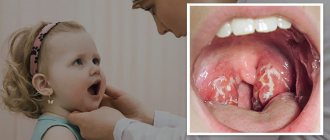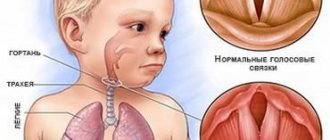The first symptoms of laryngotracheitis, treatment regimen and rules of prevention Laryngotracheitis in adults is a rather serious infectious disease. Its danger lies in the fact that the infection affects the trachea and pharynx.
This disease occurs if an adult has a severely weakened immune system. Laryngotracheitis in adults most often develops against the background of a severe cold. They say that most often laryngotracheitis occurs in those people whose work is related to public speaking - teachers, lecturers, TV presenters.
Causes of acute laryngotracheitis
There are many reasons and prerequisites for the occurrence of acute laryngotracheitis. Almost always it is of an infectious, viral or bacterial nature.
Acute laryngotracheitis is observed in the following diseases:
- Parainfluenza;
- Flu;
- Adenoviral infection;
- ARVI and acute respiratory infections;
- Chlamydial infection;
- Staphylococcal infection;
- Chickenpox;
- Scarlet fever;
- Measles;
- Rubella;
- Syphilis;
- Mycoplasmosis;
- Streptococcal infection;
- Tuberculosis of the larynx;
- Pneumococcal infection.
Laryngotracheitis occurs with the above types of diseases in case of weakened immunity in general. Sometimes only the larynx or only the trachea may be affected. There are cases of acute laryngotracheitis for other reasons. Thus, the prerequisites for the disease may be allergic reactions of the body or the aggressiveness of chemicals. Herpes lesions of the respiratory system occur, causing acute laryngotracheitis.
Classification
There are three forms of the disease:
- catarrhal, in which redness and some swelling occurs in the area of the vocal cords and trachea.
- atrophic, gradual atrophy occurs in the area of the mucous membrane, due to which it loses its protective properties and becomes inflamed. Often occurs among smokers and coal mine workers, people working in dusty areas.
- hyperplastic, the growth of areas or the entire mucosal zone in the trachea and larynx is manifested, as a result breathing and voice suffer.
There are acute and chronic laryngotracheitis. Acute laryngotracheitis is divided into
- primary, which is detected for the first time,
- recurrent, occurring repeatedly, due to the occurrence of colds or the influence of unfavorable factors.
Primary acute laryngotracheitis can have three course options:
- acutely occurring, against the background of an existing acute respiratory infection,
- sudden laryngotracheitis without signs of acute respiratory infections,
- gradually arising as a complication of colds.
The course of acute laryngotracheitis can be continuous or wavy.
Chronic laryngotracheitis occurs when acute treatment is improper or in the absence of treatment. Often occurs due to professional overstrain of the ligaments.
What is pharyngobronchitis?
Pharyngobronchitis, which is more correctly called pharyngotracheobronchitis, is an inflammatory process involving the oropharynx and trachea, with subsequent involvement of the bronchial tree. Its occurrence in children is often associated with the RS virus and parainfluenza virus type 3. During infection, the epithelium of the lower respiratory tract is damaged, inflammatory mediators are activated and the functioning of the mucociliary apparatus of the bronchi is disrupted.
The main manifestation of pharyngobronchitis is a nocturnal, paroxysmal cough. It intensifies with deep inspiration and is accompanied by chest pain, rapid and shallow breathing. In young children, during a coughing attack, vomiting and cyanosis in the area of the nasolabial triangle may occur.
Some forms of pharyngotracheobronchitis may be complicated by hemorrhagic pneumonia or laryngeal edema.
Signs
Acute laryngotracheitis in children and adults is manifested by the following symptoms:
- symptoms of general intoxication are clearly expressed;
- the throat is sore, which provokes a cough;
- barking cough (especially pronounced in a child);
- sore throat;
- voice changes. He becomes rough and hoarse. In more severe cases, aphonia is observed;
- respiratory dysfunction. A child or adult experiences wheezing, noise, and shortness of breath;
- increase in body temperature. Usually the readings do not exceed 38 degrees, but there are times when the temperature can rise to high numbers.
general information
Laryngotracheitis is a disease that combines two others:
- laryngitis - inflammation of the larynx;
- tracheitis – inflammation of the trachea.
Laryngotracheitis develops under the influence of an infection, which can be caused by viruses or bacteria. People with weakened immune systems are susceptible to it. Therefore, this disease is most often diagnosed in children under 6 years of age. This factor is explained by the imperfection of the immune system. But the disease is not uncommon in adult patients.
Laryngotracheitis responds well to treatment. But the danger is that its symptoms are often confused with other, less serious diseases (acute respiratory infections, acute respiratory viral infections). In the absence of timely treatment, laryngotracheitis becomes chronic.
Symptoms of acute laryngotracheitis
Acute laryngotracheitis is characterized by a rapid increase in symptoms. The severity of symptoms depends on the degree of damage to the tissues of the larynx and trachea.
- Infiltrative-purulent or phlegmonous laryngotracheitis, which is characterized by damage to the underlying layers of the mucosa, muscles, cartilage, is characterized by a rise in temperature to 38C - 39C.
- Catarrhal laryngotracheitis, which is characterized by damage to the internal mucous membrane and the release of mucous discharge, is characterized by a satisfactory condition of the patient, normal or slightly elevated temperature.
Acute laryngotracheitis is accompanied by severe pain in the throat and difficulty when trying to take a sip of liquid. The patient loses his appetite, he experiences increased symptoms of intoxication, and his overall condition worsens significantly.
Also characteristic symptoms of laryngotracheitis are changes in voice. It becomes hoarse, rough, and loses sonority. Laryngotracheitis is accompanied by a dry, barking cough, more often in the morning and at night. After a coughing attack, the patient feels pain in the chest. A cough can be triggered by taking a deep breath, laughing, or inhaling cold, polluted air. At first, the cough is dry, without phlegm. As the disease progresses, the cough is softened by the appearance of sputum. Over time, the sputum becomes mucopurulent and profuse. At the same time, pain, sore throat, and constant discomfort when swallowing are noted. Painful sensations occur when trying to talk, while exhaling, while inhaling. All changes are accompanied by a deterioration in general well-being.
A serious danger with laryngotracheitis is laryngeal stenosis. With this phenomenon, the access of air to the lungs is completely or largely stopped as a result of severe narrowing of the larynx. [adsense2]
Features of drug treatment
Most often, patients suffer from an infectious form of this disease. When the source of the disease is a bacterium, the use of medications is extremely necessary.
Many patients ask: how to treat laryngotracheitis in adults? The answer is quite simple. Most often in such cases, antibiotics are prescribed in the form of aerosols or tablets.
For the viral form, cough, sore throat, antiviral and other medications are usually prescribed.
These are not necessarily antibiotics. In this case, they are prescribed only as a last resort, when the disease is very advanced.
Alas, drug treatment for pregnant women and breastfeeding mothers should be especially careful.
The most effective remedies for laryngotracheitis are:
- Bioparox (in aerosol form).
- Berodual is a drug prescribed for inhalation.
- Sinekod - helps eliminate cough.
- Sumamed, Lazolvan and other similar medications.
- Erespal is a drug to relieve the inflammatory effect.
Often, a complication of laryngotracheitis, which is no longer treatable, requires surgical intervention.
The surgeon removes excess tissue, all kinds of cysts that have arisen in the larynx, etc. Recurrent disease is treated, if necessary, in the same way.
Symptoms of chronic laryngotracheitis
Particular attention should be paid to cough. If in the acute form of laryngotracheitis it is episodic and paroxysmal, then in the chronic form of this pathology the cough is permanent. Moreover, the patient constantly experiences a feeling of discomfort in the pharynx and trachea, as well as frequent painful sensations behind the sternum. A constant persistent feeling that the throat is scratched, dry mouth, painful swallowing - this is an incomplete list of manifestations of chronic laryngotracheitis.
The most characteristic diagnostic sign is dysphonia or disturbances in the patient's voice function. Dysphonia can vary in intensity from mild “hoarseness” to complete inability to speak. Attempts to make sounds cause discomfort to the patient. This condition can be aggravated by certain climatic factors or various hormonal changes. Particularly severe forms of dysphonia occur in women during menopause, during pregnancy or during menstruation. This condition can be either periodic or permanent.
Persistent dysphonia indicates various morphological changes in the structures of the vocal cords. If the patient’s professional activity involves the need to constantly communicate and be in public, the slightest changes in voice timbre can become a psychologically traumatic factor for them. As a result of this, the patient’s psychosomatic state is disrupted: sleep dysfunction, constant nervous tension, depression or neurasthenia.
Why does laryngotracheitis occur?
The acute form of laryngotracheitis is usually viral in nature.
The causative agents are viruses that cause acute respiratory viral infection or influenza. In some cases, laryngotracheitis may be a consequence of chickenpox or rubella, but this happens extremely rarely, and only in childhood. An important role in the development of the disease is played by the general condition of the body and the presence of concomitant pathologies, which significantly reduce physiological protection against infections. These factors include:
- chronic pathologies of the respiratory system;
- autoimmune disorders;
- diabetes;
- difficulty breathing through the nose;
- congestion in the lungs;
- severe hypothermia;
- constant smoking and alcohol abuse;
- chemical, thermal, mechanical damage to the mucous membrane and tissues of the larynx;
- seasonal, household, drug allergies.
In childhood, laryngotracheitis occurs due to the rapid progression of the infectious process, and in adults it is often a consequence of negligent attitude towards health. Self-treatment, non-compliance with bed rest, and bad habits complicate the common cold - this is how the pathology becomes chronic.
Laryngotracheitis is a collective concept of laryngitis and tracheitis, which develop simultaneously. Therefore, the symptoms include manifestations of both diseases. The disease develops gradually, so it is almost impossible to suspect it at the first signs. Soreness, burning and rawness in the throat are characteristic of any pathology of the larynx. Only with the addition of more indicative symptoms and on the basis of differential diagnosis can an accurate diagnosis be made.
The following signs are indicative of acute laryngotracheitis:
- increase in body temperature to 38-39°;
- rawness and soreness in the chest, especially when coughing;
- dry, turning into wet, cough with barking sounds;
- hoarseness of voice, tension of ligaments when speaking;
- noisy breathing with wheezing;
- swelling and tenderness of the submandibular lymph nodes;
- coughing attack after taking a deep breath or laughing;
- sputum when expectorated is viscous and thick, over time it can become purulent;
- feeling of lack of air or foreign body due to tracheal edema;
- general signs of intoxication are chills, fever, muscle pain, weakness, lethargy.
All these symptoms are not necessarily present in combination, but are characteristic of the acute course of laryngotracheitis. The appearance of at least one of them, especially against the background of an acute respiratory infection, should alert you and serve as an indication to consult a doctor.
Chronic laryngotracheitis occurs in adults. Its symptoms are rather vague and unremarkable. This form of the disease is characterized by problems with the voice, because the inflammatory process in the larynx primarily affects the vocal cords, disrupting their functionality. The voice may periodically disappear or become hoarse.
First aid
With laryngotracheitis, it is very important to provide assistance to the sick person even before a medical visit. And the point here is not only in the own symptoms of the disease, but also in the peculiar psychological stress that manifests itself in the sick person, especially in a child.
- It is necessary to reassure the patient, since his increased excitement can provoke an increase in frequency and deepening of spasmodic attacks.
- Be sure to provide fresh air into the room.
- In case of acute laryngospasm causing suffocation, urgently induce a gag reflex using an accessible method (for example, by pressing on the root of the tongue).
- Give the patient a warm drink - milk, dried fruit compote, mineral water, preferably a slightly alkaline one. You can add a pinch of baking soda to the milk - this is very helpful in narrowing the larynx.
- The humidity in the room where the sick person is located should be high.
- Warm foot baths (water temperature - 38-40 degrees) help relieve acute attacks. However, they cannot be done against the background of elevated body temperature.
General approach to the treatment of laryngotracheitis
If laryngotracheitis is diagnosed, treatment begins with identifying the cause of the disease. The choice of medications and the development of a treatment plan depend on this. From the first days it is necessary to take antiviral or antifungal agents to relieve inflammation.
During treatment, you should adhere to the following recommendations from otolaryngologists:
- increase the amount of warm drinks, giving preference to alkaline mineral water without gas;
- gargle with antiseptics several times a day;
- take medications to strengthen the immune system (Immunal, Interferon);
- switch to a light diet enriched with nutrients;
- in the first days, if you have difficulty swallowing, you can prepare pureed dishes, jelly, porridge;
- monitor the humidity in the room, ventilate the room every hour if necessary, use steam humidifiers.
To reduce the risk of complications, it is necessary to adhere to bed rest and get more rest. With the permission of a doctor, it is recommended to supplement the main treatment with effective folk methods.
Diagnostics
The diagnosis is made based on the results of studying the patient’s complaints, examining him and conducting some research. To determine the disease, you may need the following:
- examination of secretions released from the respiratory tract;
- results of a general urine and blood test;
- a serological study to determine the etiology of the virus that provoked the development of the disease.
An important component of the diagnosis of laryngotracheitis is the procedure for examining the laryngeal region and vocal cords. For these purposes, modern medicine provides for the use of a special apparatus, X-ray or computed tomography. In the chronic form of the disease, the patient is prescribed a biopsy of secretions in the respiratory tract to exclude oncology. Only based on the results of all the studies will the attending physician be able to determine how to treat the disease. [adsen]
Causes of pharyngotracheitis
Any viral, bacterial or fungal infection can cause pharyngotracheitis. Typically, infection occurs through airborne droplets, household or contact, and in the vast majority of cases the causative agent is viral microorganisms.
Therefore, pharyngotracheitis often occurs as a secondary disease accompanying influenza, adenoiditis, otitis media, prolonged rhinitis and other respiratory infections that affect the nasopharynx.
Important! Even when an infection penetrates the mucous membrane of the pharynx, an inflammatory process does not always develop. This requires minor provoking factors - hypothermia, stress, chronic fatigue.
The causes of bacterial pharyngotracheitis are staphylococci, Klebsiella, streptococci, Proteus, pneumococci. They penetrate the respiratory tract and cause a strong inflammatory reaction. Bacterial microorganisms penetrate the mucous membrane of the pharynx and trachea from other foci of inflammation during sore throat, sinusitis, purulent otitis, meningitis and other infectious pathologies of internal organs.
Various irritating factors can provoke inflammation:
- bad habits;
- contaminated air;
- inhalation of chemical fumes;
- allergic rhinitis;
- spicy food.
The disease occurs with a strong decrease in immunity, which is provoked by endocrine disorders, exacerbation of chronic pathologies, physical fatigue, taking cytostatics and immunosuppressants.
Complications
Significant swelling and accumulation of sputum in the lumen of the larynx during acute laryngotracheitis can become a reason for the development of such a serious complication as stenosing laryngotracheitis, or false croup.
Chronic laryngotracheitis under certain circumstances can give rise to the development of tracheitis, bronchitis, bronchiolitis and pneumonia. In addition, constant irritation of the mucous membrane of the larynx and trachea can contribute to the appearance of a benign or malignant tumor. Complications of hypertrophic laryngotracheitis may include the appearance of laryngeal ventricular prolapse or laryngeal ulcers, and the formation of cysts.
How to treat laryngotracheitis?
Typically, inflammation of the upper respiratory tract does not require hospitalization of an adult patient (except in cases of stenosing laryngotracheitis), so treatment at home is more often used:
- Eliminate all harmful factors that provoke the development of laryngotracheitis (prohibit smoking, talking, drinking and eating hot, spicy, sour foods);
- The patient is given a warm room with humidified air, given a lot of warm (but not hot and irritating) drinks (jelly, teas, compotes);
- If the temperature crosses the border of low-grade fever (38°C), reduce it with paracetamol, ibuprofen or other antipyretics available in the house;
- They do alkaline inhalations at home, and when the temperature drops or during a chronic course of the disease, they invite the patient to visit the physiotherapy room of the clinic (inhalations, electrophoresis, UHF, etc.)
- They give expectorants and antitussives, use antihistamines;
- The patient should not rush to prescribe antibiotics at his own discretion, just like his parents, if it concerns a child. Laryngotracheitis, which is of viral origin, still does not respond to them, so the body does not need these drugs. In general, antibacterial and antiviral treatment at home is carried out under the supervision of a doctor.
In case of chronic hypertrophic laryngotracheitis, in cases where there is no effect from conservative therapy or there is a threat of transformation into a neoplastic process, surgical intervention is resorted to. Excision of overgrown tissue, elimination of ventricular prolapse, and removal of cysts are performed using endoscopic microsurgical technologies. [adsense3]
Folk remedies
It is usually possible to achieve complete recovery from laryngotracheitis in 7-10 days if you follow the doctor’s prescriptions and follow general recommendations, including the use of folk remedies:
- inhalations with soda;
- inhaling steam from boiled potatoes;
- inhalations with healing essential oils: fir, juniper, eucalyptus, tea tree oil.
The medicinal properties of onion inhalations and decoctions of onion pulp are described. There is a healing anti-inflammatory effect of honey and garlic mixed with various herbs, roots, fruits and plants.
The herbs of St. John's wort, wild rosemary, oregano, coltsfoot, plantain leaves, mullein and nettle flowers, marshmallow and licorice roots, and fennel fruits have a positive effect. Radish juice with honey, potato and beet juice, a decoction of anise seeds, carrot juice with milk, a herd of raisins with onions will help restore your voice and ease your breathing.
Prevention
Prevention of laryngotracheitis consists of a set of measures:
- breathing exercises;
- hardening from an early age;
- diet excluding spicy, salty, sour, hot or cold foods;
- sports are required;
- prevention of ARVI;
- prevention of inflammatory processes in the larynx;
- prevent hypothermia of the body;
- taking immunomodulatory drugs.
If laryngotracheitis proceeds normally, without complications, then recovery occurs within a week. You should not self-medicate; the treatment process should be under the supervision of the attending physician.











